INTRODUCTION
Resistance has become a significant problem globally (CDC, 2020; WHO, 2020). The possible cause of the rise in resistance is the unreasonable and irresponsible use of antibiotics in healthcare centers such as hospitals and the community. Excessive prescribing, inappropriate use of antibiotics, and self-medication with antibiotics (SMA) may accelerate antibiotic resistance (ABR) (Ventola, 2015). ABR results in bacteria failing to respond to treatment, resulting in prolonged infectious diseases, extended hospital stays, and an increased risk of death (WHO, 2020).
Antibiotics are a type of drug used to treat and prevent bacterial infections. According to Law No. 419, dated December 22, 1949, antibiotics can only be obtained in pharmacies with a doctor’s prescription. Nevertheless, many people practice SMA for their illnesses. SMA practice occurs in developing and developed countries (Abduelkarem et al., 2019; Alhomoud et al., 2017; Al Rasheed et al., 2016). SMA is defined as self-initiative in using drugs to treat health problems or symptoms of disease based on self-diagnosis or advice from those who are not health professionals toward intermittent disease or prolonged use of drug prescription for chronic or recurrent disease (WHO, 2000).
A previous study conducted as preliminary and qualitative research in Boyolali Regency, Central Java, Indonesia, revealed that respondents consumed antibiotics for self-medication for diseases that did not require antibiotics, such as flu, fever, cough, headache, and toothache (Karuniawati et al., 2020). In addition to using antibiotics for self-medication for symptoms due to viruses, previous studies also suggested that more than 50% of respondents fed antibiotics to livestock based on self-initiative (Karuniawati et al., 2021a). Therefore, the inappropriate use of antibiotics should be reduced so that the increase in ABR can be minimized.
Understanding the prevalence of SMA, reasons for using antibiotics for self-medication, and factors that influence the use of antibiotics for self-medication, is fundamental to reducing the inappropriate use of antibiotics and improving the rational use of antibiotics. This information will guide the formulation of educational interventions, especially for identifying and determining educational content and the priorities of respondents who need to be reached so that the intervention is carried out according to the respondent’s needs. According to WHO (2012), good educational materials must be in accordance with the needs of the individual or community to be educated. Although studies on the prevalence and factors influencing the use of antibiotics in self-medication are available in both developed and developing countries, such research is still limited in Indonesia. A study conducted in Indonesia in 2011 reported the prevalence and factors that influence SMA (Widayati et al., 2011). However, this study did not test knowledge of antibiotics as a contributing factor for SMA. On the other hand, a study has stated that knowledge influences antibiotic behavior (Karuniawati et al., 2021b). Therefore, it is necessary to conduct further research to determine the prevalence of and reasons for SMA and contributing factors (demographics and antibiotics knowledge) associated with SMA.
METHODS
Study design and sampling
This study is a community-based cross-sectional study. The research was conducted in Boyolali from November 2019 to May 2020. Data were probed on respondents in seven subdistricts in Boyolali. One subdistrict was in the city’s center, the other was the most backward area, and the remaining were randomly selected (WHO, 2005). The Raosoft sample size calculator was used to calculate the sample size (Raosoft, 2018). The minimum estimated sample size was 576 for a population of 1 million (Boyolali Regency, Indonesia, according to the Department of Statistics, Indonesia), with a 95% confidence interval, a 5% margin of error, and a 50% increase to reduce the weakness of cluster sampling and increase the representative sample (Hardon et al., 2004). A total of 130–140 respondents were selected in each subdistrict. The inclusion criteria in this study were as follows: the general public over the age of 17 years can read and write and become respondents by completing the questionnaire. Exclusion criteria were those with a health education history and working in the health sector to minimize the bias because they had received health education, including antibiotics. Data were procured using a questionnaire validated in previous studies (Karuniawati et al., 2022). Respondents were visited and asked to fill out a questionnaire. The main target of the respondent was the head of the family. Still, if at the time of data collection, the head of the family was not present, then the questionnaire was left or other family members with a minimum age of 17 years may fill out the questionnaire under the condition that the head of the family was not present for a long time. A family with several members was only given one questionnaire.
Study instrument
This study administered a questionnaire that had been validated and tested for reliability (Karuniawati et al., 2022). The questionnaire consists of three sections with closed- and open-ended questions. Part one comprises respondents’ demographic data, namely, gender, age, marital status, background education, domicile, employment status, and family income. The second part contains questions related to the practice of SMA, including sources of antibiotics for SMA (if the patient gets antibiotics from a friend or relative, buys them at a stall, buys them in supermarkets, buys them at the pharmacy without a doctor’s prescription, or uses leftover antibiotics from previous treatment, this is categorized as SMA), reasons for practicing SMA, symptoms treated with SMA, types of antibiotics for SMA, and side effects of antibiotics. Finally, the third part is a question about the respondents’ knowledge of antibiotics, with “yes,” “no,” and “don’t know” responses.
Ethical approval
This study obtained ethical clearance from the health research ethics committee, Faculty of Medicine, Universitas Muhammadiyah Surakarta, No. 2063/B.1/KEPK-FKUMS/III/2019. Before filling out the questionnaire, respondents were informed about the research and signed the informed consent form to participate in this study. The confidentiality of participants’ information was guaranteed.
Analysis
The obtained data were inserted into a Microsoft Excel spreadsheet and then exported to Statistical Package for the Social Sciences. The data were analyzed in a descriptive and analytical manner. Descriptive analysis was applied to describe demographic data and data related to SMA practices in percentage and mean (SD) scope. The results on the respondent’s knowledge of antibiotics are presented in two categories: “true” and “wrong” answers. Responses of “don’t know” are categorized as “wrong” answers. The “true” answer to the knowledge question about antibiotics scored 1, while the “wrong” or “don’t know” earned 0. The total score for the correct answer to the question regarding antibiotic knowledge was 20 (Karuniawati et al., 2021b). All the responses to the knowledge question were summed, and the median score was calculated. Scores above the median value were categorized as good knowledge (Alkhalifah et al., 2022). A chi-square analysis was employed to find the relationship between demographics and knowledge of SMA practice. Furthermore, multivariate logistic regression was used to determine the factors influencing the behavior of SMA. A p-value less than 0.05 is deemed significant.
RESULTS
In this study, 961 respondents participated, with nearly equal percentage of male and female respondents (46.9% vs. 53.1%). More than 50% of respondents were 30 and 50 years old (mean 36.9 ± 12.7, range 17–77), were married, lived in rural areas, were employed, and had an income per capita below the regional minimum wage. The demographic profiles of the respondents are presented in Table 1.
During the study, 16% (154 of 961) of respondents used antibiotics for self-medication, and 72 (7.5%) obtained antibiotics from pharmacies without a doctor’s prescription. Other sources show that some bought them at the shop, took leftover antibiotics from previous treatment, or got them from friends or relatives. The most frequent reasons for SMA practice are based on experiences that the same medicine could cure similar diseases and long queues of doctor’s visits. The symptoms most often treated with SMA are flu/colds, fever, diarrhea, cough, toothache, and skin complaints such as itching or skin infections. Antibiotics often consumed are amoxicillin and tetracycline. The potential side effects experienced by respondents while using antibiotics as self-medication are itching, skin redness, and diarrhea. More than 70% of respondents did not experience side effects. The characteristics of SMA are depicted in Table 2.
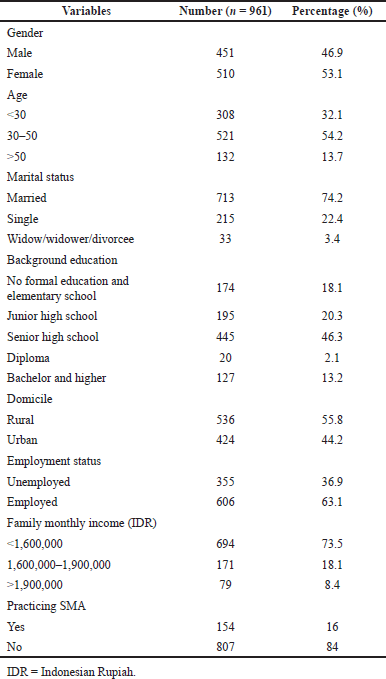 | Table 1. Demographic characteristics of respondents. [Click here to view] |
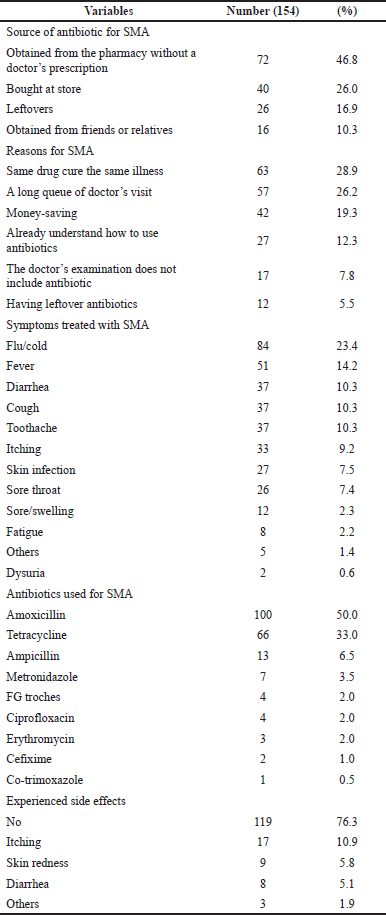 | Table 2. Characteristics of SMA practice. [Click here to view] |
The characteristics of respondents’ knowledge of antibiotics are displayed in Table 3. More than half of respondents answered incorrectly on the following items: paracetamol is an antibiotic, antibiotics can be used to treat infections due to viruses, antibiotics can reduce fever, antibiotics can be bought online, antibiotics can be purchased at a pharmacy without a doctor’s prescription, antibiotics can kill bacteria in the intestines, antibiotics need to be stored in case of illness in the future, and antibiotics can be stopped if the ill has improved. Also, Table 3 describes the significant relationship between knowledge in the domains of identification of antibiotics (Q3), knowledge of antibiotics access (Q9–Q10), knowledge of antibiotics misuse effects (Q12), knowledge of side effects of antibiotics (Q16–Q17), and knowledge of antibiotic use (Q18–Q20) on SMA practice. Table 4 explains the relationship between respondent sociodemographic variables and SMA: age, marital status, and employment status related to SMA.
A multivariate logistic regression analysis was carried out to determine the variables that influenced SMA because the scale of measurement on the independent and dependent variables was categorical. The variables from the bivariate test that had p < 0.25 were age, marital status, employment status, and knowledge of antibiotics (Q1, Q3, Q9, Q10, Q11, Q12, Q13, Q14, Q15, Q16, Q17, Q18, Q19, Q20) were tested using multivariate logistic regression (Dahlan, 2017). The results of the multivariate logistic regression test are shown in Table 5.
The results of multivariate logistic regression imply that age, marital status, employment status, knowledge of access to antibiotics (Q9–Q10), and knowledge of antibiotics misuse effect (Q12 and Q15) had a significant effect on high SMA practice (p < 0.05). Respondents aged <30 and >50 years had a prevalence of practicing SMA 1.7 times higher than respondents aged 30–50 years. Those single respondents had the possibility of committing SMA nearly two times more often, and widows/widowers/divorcees had the chance of practicing SMA 2.8 times more often than married respondents. Furthermore, unemployed respondents were likely to practice SMA 1.5 times more often than employed ones. Respondents who answered incorrectly in the antibiotic access question domain (Q9–Q10) and the knowledge on antibiotic misuse effect domain (Q12) were more likely to perform SMA approximately 1.5–1.8 times more frequently than those who answered correctly. Yet, in contrast to the question in Q15, respondents who answered incorrectly appeared to commit SMA 0.6 times more than those who answered correctly on the question.
DISCUSSION
The results of this study indicate that 16% (154 of 961) of the respondents practiced SMA. This prevalence is smaller than the results of studies in several other countries such as Malaysia, the Philippines, Africa, the United Arab Emirates, the Kingdom of Saudi Arabia, and Ethiopia (Abduelkarem et al., 2019; Al Rasheed et al., 2016; Ateshim et al., 2019; Bilal, 2016; Bogale et al., 2019; Bulario et al., 2018; Haque et al., 2019). This prevalence is also relatively lower than a similar study in Manado, Indonesia, in 2015, which suggested that 180 (45%) respondents had practiced self-medication (Kurniawan et al., 2017). This relatively small prevalence may be due to the GeMa CerMat program (Gerakan Masyarakat Cerdas Menggunakan Obat or People’s Movement to Use Medicines Smartly), which has been implemented in Indonesia since 2015. Based on the Decree of the Minister of Health of the Republic of Indonesia Number HK.02.02/MENKES/427/2015, GeMa CerMat is the government and community’s efforts through a series of activities to create vigilance, awareness, understanding, and skills among the community in using drugs appropriately and correctly, including antibiotics. The purpose of this program is to enhance public understanding and awareness about the importance of using drugs correctly, increase independence and change the public’s behavior toward using drugs properly, and improve the rational use of drugs, including antibiotics. As per regulations in Indonesia, antibiotics can only be obtained in pharmacies with a doctor’s prescription (Kepmenkes, 2015, 2020).
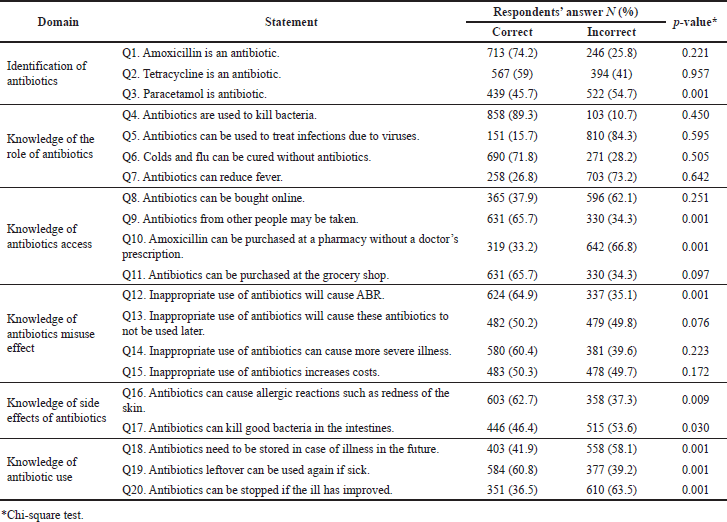 | Table 3. Respondent knowledge of antibiotics and their relationship with SMA (n = 961). [Click here to view] |
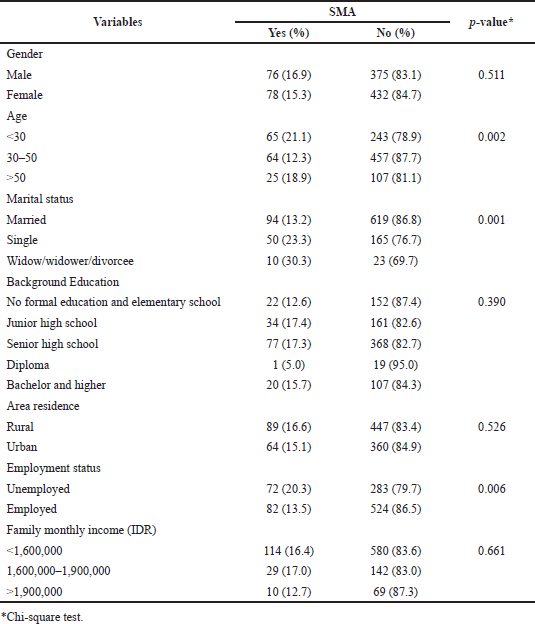 | Table 4. The relationship of sociodemographic characteristics of participants and SMA (n = 961). [Click here to view] |
Respondents using antibiotics for SMA purchased them from pharmacies without a doctor’s prescription, bought them at a shop, used leftover antibiotics from previous treatment, or obtained them from friends or relatives. The results of this study correspond to other studies. Previous studies mentioned that community pharmacies and other healthcare centers, relatives or friends, leftover drugs, and patent medicine stores were the primary sources of respondents in obtaining antibiotics for SMA (Abduelkarem et al., 2019; Aslam et al., 2021; Bulario et al., 2018; Mohanna, 2010; Nepal and Bhatta, 2018). In addition, patients used the previous prescription or an empty package to obtain antibiotics (Mohanna, 2010; Torres et al., 2019). Previous research revealed that 42% (58 out of 138) of shops surveyed in Indonesia sold antibiotics such as tetracycline, penicillin, amoxicillin, and ampicillin (Karuniawati et al., 2021a). In this study, the most frequently used antibiotics in SMA were amoxicillin (50%), tetracycline (33%), and ampicillin (6.5%). This is in line with the results of several previous studies and reviews, which revealed that penicillin (amoxicillin) was the most frequently used antibiotic for SMA (Abduelkarem et al., 2019; Alhomoud et al., 2017; Al Rasheed et al., 2016; Ateshim et al., 2019; Bilal, 2016; Bulario et al., 2018; Horumpende et al., 2018; Jassim, 2010; Mohanna, 2010; Torres et al., 2020; Yeika et al., 2021).
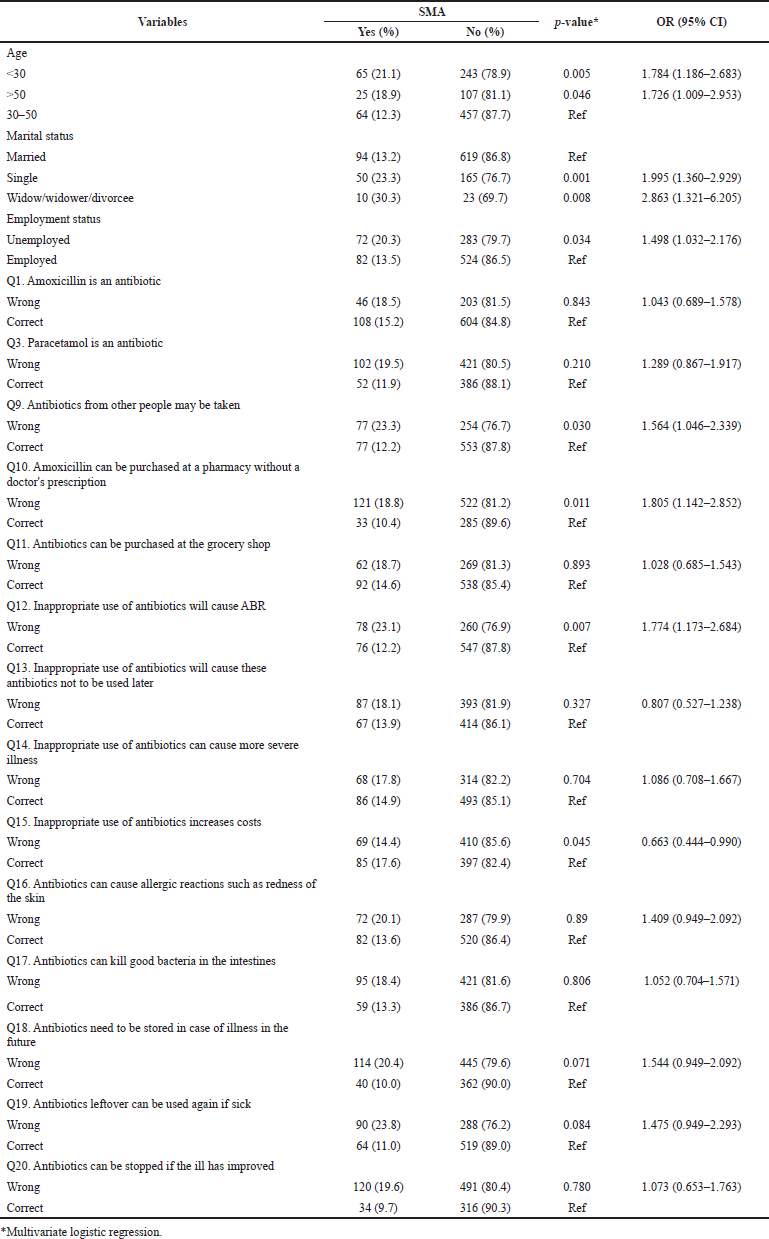 | Table 5. The association between sociodemographic and knowledge variables and SMA practice and its odds ratio (ORs). [Click here to view] |
According to the respondents, the practice of SMA was carried out because they had experience using antibiotics in previous illnesses with the same medicine treating the same disease and respondents already understood how to use antibiotics. Other reasons for practicing SMA are long queues for doctor’s visits, saving money, a doctor’s examination that does not include antibiotics, and antibiotics leftover. In addition, the previous studies revealed that the participants reported their previous successful experience with a similar illness with the antibiotic treatment; respondents thought that they could effectively diagnose and treat themselves every time they experienced the same symptoms and the illness was not serious enough to seek medical care. Other important factors included the following: economic reasons; suggestions from others; advertisements on television, radio, and print media; time-wasting and inconvenience to keep on visiting the physician (Abduelkarem et al., 2019; Ateshim et al., 2019; Bilal, 2016; Haque et al., 2019; Nepal and Bhatta, 2018; Rather et al., 2017).
In this study, the disease symptoms most often treated with antibiotics on their initiative were flu or the common cold, fever, diarrhea, cough, toothache, itching and skin infections, and sore throat. Previous research stated that nonprescription antibiotics were used to treat self-perceived sore throat, fever, pain, cough, vaginal discharge, eye problems, common influenza, urinary tract infections, gastrointestinal tract disease, respiratory tract infections, skin infections, ear infections, wounds, headache, diarrhea, and toothaches or gum symptoms (Haque et al., 2019; Horumpende et al., 2018; Grigoryan et al., 2007; Jassim, 2010; Mohanna, 2010; Nepal and Bhatta, 2018; Torres et al., 2020; Yeika, 2021). Of the 961 respondents, 76.3% reported never experiencing side effects of SMA, whereas 10.9% experienced itching, and approximately 5% experienced skin redness and diarrhea.
The results of multivariate logistic regression analysis showed that age, marital status, employment status, and knowledge of access to antibiotics (in the questions: Q9. Antibiotics from other people may be taken; Q10. Amoxicillin can be purchased at a pharmacy without a doctor’s prescription), knowledge on antibiotics misuse effect (in the questions: Q12. Inappropriate use of antibiotics will cause ABR; Q15. Inappropriate use of antibiotics increases costs) significantly affected self-medication practice (p < 0.05). Respondents of <30 and >50 years were more prone to practice SMA 1.7 times more often than those aged 30–50. Similar findings were observed in a study conducted in Ethiopia, which revealed that SMA was significantly associated with age. Respondents aged 18–30 were 8.5 times more likely to commit SMA (Bogale et al., 2019). Another study affirmed that the younger the respondents are, the more likely they were to practice SMA: respondents aged <25 and 25–34 had 4.5 times and 2.7 times, respectively (Gebeyehu et al., 2015). Similar research examined in Manila involving mothers as respondents suggested that as the mother’s age increases, the mother’s tendency to self-medicate her child also increases (p = 0.029) (Bulario et al., 2018). Research in China also reported that older age was a risk factor for SMA (p < 0.01) (Pan et al., 2012). However, these findings contradict the study conducted in Saudi Arabia, which discovered that respondents aged 45 years were more likely to practice SMA 2.9 times more than those younger (p = 0.010) (Al Rasheed et al., 2016).
Previous studies conducted in Tanzania, Nigeria, and Ethiopia showed a significant effect between marital status and SMA practice (Afolabi, 2008; Kifle et al., 2021; Horumpende et al., 2018). It corresponds with this study where single and widows/widowers/divorcees intent to self-medicate with antibiotics was 1.99–2.86 times more frequent than that of married participants (p = 0.001). Nonetheless, this study does not align with research conducted in Iran and Iraq, where marital status is unrelated to SMA (Ahmed, 2016; Mousavi et al., 2020). Furthermore, in this study, respondents who were unemployed and had poor knowledge of antibiotics tended to practice SMA more often than those who worked. Again, this finding aligned with the previous studies (Ateshim et al., 2019; Haque et al., 2019; Kajeguka and Moses, 2017; Kurniawan et al., 2017).
Strengths and limitations
The strength of this study is that the respondents included those who live in urban and rural areas with varying ages, income levels, and education levels. Therefore, the results of this study could represent the entire population. On the other hand, some respondents were not doing SMA at the time of data collection, so respondents tried to remember when the last SMA occurred, which might allow for a recall bias. To minimize bias, it is recommended in future studies that data collection be performed on patients who are currently taking antibiotics during the data collection.
CONCLUSION
During the study, 16% (n = 154) of the respondents practiced SMA. Sources of antibiotics for self-medication were pharmacy (46.8%), shop or stall (26.0%), leftovers (16.9%), and friends/relatives (10.3%). Age, marital status, employment status, and knowledge of antibiotics have a significant relationship with SMA practice (p < 0.05).
The results of this study can be used to evaluate the GeMa CerMat program implemented and be considered in designing further education to minimize SMA practice. Furthermore, these findings may provide an excellent foundation for future research into the areas that must be prioritized, the best educational resources, and the most effective teaching strategies for more focused, targeted interventions. Respondents were <30 and >50 years; single, widowers, divorcees, and unemployed can be considered the main targets in future interventions. Moreover, knowledge of antibiotic function, how to distinguish and obtain antibiotics according to regulations, and the effects of using irrational antibiotics can be priority material in future public education. Furthermore, it is necessary to strictly supervise the distribution of antibiotics so that they can only be obtained as per applicable laws and regulations.
ACKNOWLEDGMENTS
The authors would like to thank Professor Mohamed Azmi Ahmad Hassali for all the support and guidance and all respondents for participating in this study.
AUTHORS’ CONTRIBUTIONS
HK initiated the study, conceptualization and design, data curation, and analysis, prepared the draft, and approved the final publishable manuscript. SS was responsible for the conceptualization and design, supervision, interpretation, critical review of the article, and approval of the final publishable manuscript. SASS contributed to the supervision, interpretation, critical review of the article, and approval of the final manuscript. TT was responsible for the analysis and interpretation of data, critical review manuscript, and approval of the final publishable manuscript. WHI was responsible for the analysis of data, drafting, and approval of the final publishable manuscript. MSH critically edited the manuscript, evaluated the scientific quality, and approved the final publishable manuscript.
FUNDING
This study was funded by the Universitas Muhammadiyah Surakarta (Reference No. 565/A.3-II/BPSDM/VII/2018).
CONFLICTS OF INTEREST
The authors declare no conflicts of interest.
ETHICAL APPROVALS
This study obtained ethical clearance from the Health Research Ethics Committee, Faculty of Medicine, Universitas Muhammadiyah Surakarta, No. 2063/B.1/KEPK-FKUMS/ III/2019.
DATA AVAILABILITY
The research data is available upon a reasonable request to the corresponding author.
PUBLISHER’S NOTE
This journal remains neutral with regard to jurisdictional claims in published institutional affiliation.
REFERENCES
Abduelkarem AR, Othman AM, Abuelkhair ZM, Ghazal MM, Alzouobi SB, Zowalaty MEE. Prevalence of self-medication with antibiotics among residents in United Arab Emirates. IDR, 2019; 12:3445–53. CrossRef
Afolabi A. Factors influencing the pattern of self-medication in an adult Nigerian population. Ann Afr Med, 2008; 7(3):120. CrossRef
Ahmed NM. Self-medication practice among patients attending a sample of primary health care centers in Erbil City. J Educ Pract, 2016; 7:73–9.
Al Rasheed A, Yagoub U, Alkhashan H, Abdelhay O, Alawwad A, Al Aboud A, Al Battal S. Prevalence and predictors of self-medication with antibiotics in Al Wazarat Health Center, Riyadh City, KSA. BioMed Res Int, 2016; 2016:e3916874. CrossRef
Alhomoud F, Aljamea Z, Almahasnah R, Alkhalifah K, Basalelah L, Alhomoud FK. Self-medication and self-prescription with antibiotics in the Middle East—do they really happen? A systematic review of the prevalence, possible reasons, and outcomes. Int J Infect Dis, 2017; 57:3–12. CrossRef
Alkhalifah HM, Alkhalifah KM, Alharthi AF, Elzahrany YR, Aljuhani MA. Knowledge, attitude and practices towards antibiotic use among patients attending Al Wazarat health center. J Fam Med Prim Care, 2022; 11(4):1299. CrossRef
Aslam A, Zin CS, Rahman NSA, Gajdács M, Ahmed SI, Jamshed S. Self-medication practices with antibiotics and associated factors among the public of Malaysia: a cross-sectional study. DHPS, 2021; 13:171–81. CrossRef
Ateshim Y, Bereket B, Major F, Emun Y, Woldai B, Pasha I, Habte E, Russom M. Prevalence of self-medication with antibiotics and associated factors in the community of Asmara, Eritrea: a descriptive cross sectional survey. BMC Public Health, 2019; 19(1):726. CrossRef
Bilal M. Self-medication with antibiotics among people dwelling in rural areas of Sindh. JCDR [Internet], 2016. Available via http://jcdr.net/article_fulltext.asp?issn=0973-709x&year=2016&volume=10&issue=5&page=OC08&issn=0973-709x&id=7730 (Accessed 2 April 2021).
Bogale AA, Amhare AF, Chang J, Bogale HA, Betaw ST, Gebrehiwot NT, Fang Y. Knowledge, attitude, and practice of self-medication with antibiotics among community residents in Addis Ababa, Ethiopia. Expert Rev Anti Infect Ther, 2019; 17(6):459–66. CrossRef
Bulario JS, Cruz ILP, Pilapil MC, Gutierrez MM. Factors associated with parental self-medication of antibiotics in health centers of Manila. KSS, 2018; 3(6):891. CrossRef
CDC. Antibiotic resistance: a global threat [Internet]. 2020. Available via https://www.cdc.gov/drugresistance/solutions-initiative/stories/ar-global-threat.html (Accessed 5 July 2021).
Dahlan. Statistik untuk Kedokteran dan Kesehatan, Deskriptif, Bivariat, Dan Multivariat Dilengkapi Aplikasi Dengan Menggunakan SPSS. 5th edition, Salemba Medika, Jakarta, Indonesia, no. 1, 2017.
Gebeyehu E, Bantie L, Azage M. Inappropriate use of antibiotics and its associated factors among urban and rural communities of Bahir Dar City Administration, Northwest Ethiopia. PLoS One, 2015; 10(9):e0138179. CrossRef
Grigoryan L, Burgerhof JGM, Haaijer-Ruskamp FM, Degener JE, Deschepper R, Monnet DL, Di Matteo A, Scicluna EA, Bara AC, Lundborg CS, Birkin J. Is self-medication with antibiotics in Europe driven by prescribed use? J Antimicrob Chemother, 2007; 59(1):152–6. CrossRef
Haque M, Rahman NAA, McKimm J, Kibria GM, Majumder MAA, Haque SZ, Islam MZ, Binti Abdullah SL, Daher AM, Zulkifli Z, Rahman S, Kabir R, Lutfi SNNB, Aishah Binti Othman NS. Self-medication of antibiotics: investigating practice among university students at the Malaysian National Defence University. IDR, 2019; 12:1333–51. CrossRef
Hardon A, Hodgkin C, Fresle D. How to investigate the use of medicines by consumers. World Health Organization, Geneva, Switzerland, vol. 98, 2004.
Horumpende PG, Said SH, Mazuguni FS, Antony ML, Kumburu HH, Sonda TB, Mwanziva CE, Mshana SE, Mmbaga BT, Kajeguka DC, Chilongola JO. Prevalence, determinants and knowledge of antibacterial self-medication: a cross sectional study in North-eastern Tanzania. PLoS One, 2018; 13(10):e0206623. CrossRef
Jassim AM. In-home drug storage and self-medication with antimicrobial drugs in Basrah, Iraq. Oman Med J, 2010; 25(2):79–87. CrossRef
Kajeguka DC, Moses E. Self-medication practices and predictors for self-medication with antibiotics and antimalarials among community in Mbeya City, Tanzania. Tanzania J Health Res [Internet], 2017; 19(4). Available via https://www.ajol.info/index.php/thrb/article/view/146395 (Accessed 16 July 2021).
Karuniawati H, Hassali MAA, Ismail WI, Taufik T, Suryawati S. Antibiotic use in animal husbandry: a mixed-methods study among general community in Boyolali, Indonesia. Int J One Health, 2021a; 7(1):122–7. CrossRef
Karuniawati H, Hassali MAA, Suryawati S, Ismail WI, Taufik T, Hossain MS. Assessment of knowledge, attitude, and practice of antibiotic use among the population of Boyolali, Indonesia: a cross-sectional study. Int J Environ Res Public Health, 2021b; 18(16):8258. CrossRef
Karuniawati H, Hassali MAA, Suryawati S, Ismail WI, Taufik T, Mutalazimah M. Development and validation of knowledge, attitude, and practice towards antibiotics questionnaire (KAPAQ) for general community. Res J Pharm Technol, 2022; 15(1):315–24. CrossRef
Karuniawati H, Hassali MAA, Suryawati S, Ismail WI, Taufik T, Wiladatika A. Public practices towards antibiotics: a qualitative study. Clin Epidemiol Glob Health [Internet], 2020. Available via http://www.sciencedirect.com/science/article/pii/S2213398420301238 (Accessed 16 September 2021).
Kepmenkes. Kepmenkes-No-427-Tahun-2015-tentang-GEMA-CERMAT.pdf [Internet]. Scribd, Jakarta, Indonesia, 2015. Available via https://www.scribd.com/document/419788480/Kepmenkes-No-427-Tahun-2015-tentang-GEMA-CERMAT-pdf (Accessed 26 May 2021).
Kepmenkes. Pedoman Pelaksanaan Program Gerakan Masyarakat Cerdas Menggunakan Obat (Gema Cermat). Kementerian Kesehatan Republik Indonesia, Jakarta, Indonesia, 2020.
Kifle ZD, Mekuria AB, Anteneh DA, Enyew EF. Self-medication practice and associated factors among private health sciences students in Gondar Town, North West Ethiopia. A cross-sectional study. Inquiry, 2021; 58:00469580211005188. CrossRef
Kurniawan K, Posangi J, Rampengan N. Association between public knowledge regarding antibiotics and self-medication with antibiotics in Teling Atas Community Health Center, East Indonesia. Med J Indones, 2017; 26(1):62–9. CrossRef
Mohanna M. Self-medication with antibiotic in children in Sana’a City, Yemen. OMJ [Internet], 2010; 25(1). Available via http://www.omjournal.org/OriginalArticles/FullText/201001/FT_Self-medicationwithAntibioticinChildreninSanaCity.html (Accessed 2 April 2021). CrossRef
Mousavi F, Shojaei P, Nazemi A, Dadashi A. A cross-sectional study of antibiotic self-medication. Thrita [Internet], 2020; 9(1). Available via https://sites.kowsarpub.com/thrita/articles/105794.html#abstract (Accessed 15 July 2021). CrossRef
Nepal, Bhatta S. Self-medication with antibiotics in WHO Southeast Asian Region: a systematic review. Cureus [Internet], 2018; 10(4). Available via https://www.ncbi.nlm.nih.gov/pmc/articles/PMC5988199/ (Accessed 2 April 2021). CrossRef
Pan H, Cui B, Zhang D, Farrar J, Law F, Ba-Thein W. Prior knowledge, older age, and higher allowance are risk factors for self-medication with antibiotics among university students in Southern China. PLoS One, 2012; 7(7):e41314. CrossRef
Raosoft. Sample size calculator by Raosoft, Inc. [Internet]. 2018. Available via http://www.raosoft.com/samplesize.html (Accessed 13 September 2018).
Rather IA, Kim BC, Bajpai VK, Park YH. Self-medication and antibiotic resistance: crisis, current challenges, and prevention. Saudi J Biol Sci, 2017; 24(4):808–12. CrossRef
Torres NF, Solomon VP, Middleton LE. Patterns of self-medication with antibiotics in Maputo City: a qualitative study. Antimicrob Resist Infect Control, 2019; 8(1):161. CrossRef
Torres NF, Solomon VP, Middleton LE. Identifying the commonly used antibiotics for self-medication in urban Mozambique: a qualitative study. BMJ Open, 2020; 10(12):e041323. CrossRef
Ventola CL. The antibiotic resistance crisis. Pharm Ther, 2015; 40(4):277–83.
WHO. Guideline for the regulatory assessment of medical products for use in self-medication [Internet]. 2000. Available via https://apps.who.int/iris/bitstream/handle/10665/66154/WHO_EDM_QSM_00.1_eng.pdf?sequence=1&isAllowed=y (Accessed 10 May 2021).
WHO. Immunization coverage cluster survey: reference manual. 2005. Available via https://apps.who.int/iris/handle/10665/69087 (Accessed 21 December 2019).
WHO. Health education: theoretical concepts, effective strategies and core competencies. Health Promotion Pract, 2012; 15(5):619–21. CrossRef
WHO. Antibiotic resistance [Internet]. 2020. Available via https://www.who.int/news-room/fact-sheets/detail/antibiotic-resistance (Accessed 7 November 2019).
Widayati A, Suryawati S, de Crespigny C, Hiller JE. Self medication with antibiotics in Yogyakarta City Indonesia: a cross sectional population-based survey. BMC Res Notes, 2011; 4:491. CrossRef
Yeika EV, Ingelbeen B, Kemah BL, Wirsiy FS, Fomengia JN, Sande MAB van der. Comparative assessment of the prevalence, practices and factors associated with self-medication with antibiotics in Africa. Trop Med Int Health [Internet]. 2021. Available via https://onlinelibrary.wiley.com/doi/abs/10.1111/tmi.13600 (Accessed 12 July 2021). CrossRef